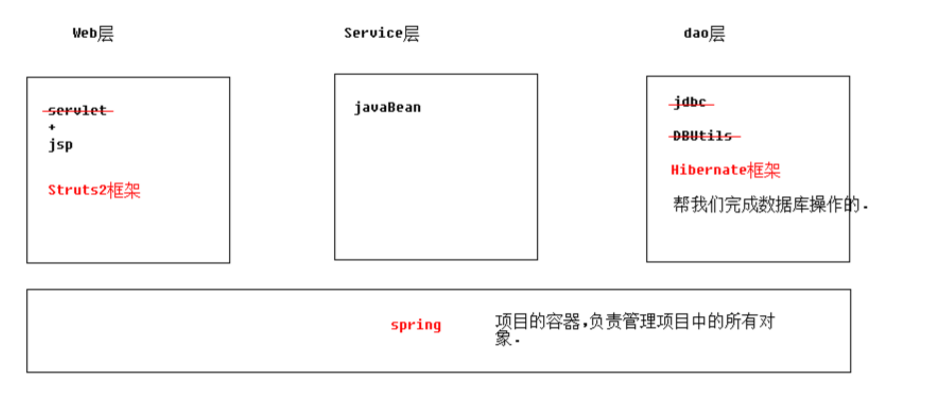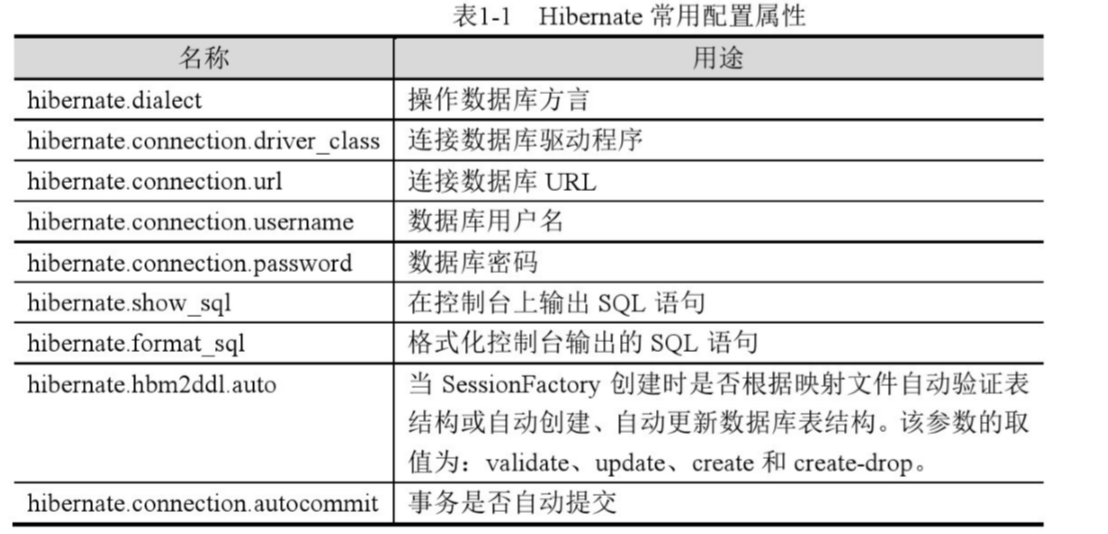1.hibernate介绍
(1)hibernate框架是什么?
hibernate是一款开源的持久层的ORM框架(ORM:object relational mapping. 对象关系映射),它对JDBC进行了轻量级的对象封装,使得Java开发人员可以以面向对象的编程思想来操作数据库。
所谓ORM,就是利用描述对象和数据库表之间映射的元数据,自动把Java程序中的对象,持久化到关系型数据库表中。
ORM分为4个级别,DBUtils属于1级,MyBatis属于2级,Hibernate属于4级(完全面向对象操作数据库)

(2)hibernate的好处
操作数据库的时候,可以以面向对象的方式来完成.不需要书写SQL语句。
2.Hibernate框架的搭建
(1)导包
hibernate-release-5.0.7.Final\lib\required下的所有jar包。+一个数据库驱动包
(2)创建数据库,准备表,实体类(通过配置文件可以自动生成表,不需要建表也可以)
(3)书写orm元数据(实体类和表的映射文件)
(3.1)导入约束,书写配置文件(实体类和表的映射文件使用mapping约束,主配置文件使用configuration约束)
导入约束:hibernate-mapping-3.0.dtd(注意:key type选择URI)
(书写主配置文件时,在project/etc/Hibernate.properties文件里有相关信息,直接复制即可)
常用属性:

这是实体类
private Long cust_id;
private String cust_name;
private String cust_source;
private String cust_industry;
private String cust_level;
private String cust_linkman;
private String cust_phone;
private String cust_mobile;
......配置实体类和数据库表的映射关系文件Customer.hbm.xml(含详解):
<?xml version="1.0" encoding="UTF-8"?>
<!DOCTYPE hibernate-mapping PUBLIC
"-//Hibernate/Hibernate Mapping DTD 3.0//EN"
"http://www.hibernate.org/dtd/hibernate-mapping-3.0.dtd">
<!-- 配置表与实体对象的关系 -->
<!-- package属性:填写一个包名.在元素内部凡是需要书写完整类名的属性,可以直接写简单类名了. -->
<hibernate-mapping package="cn.itheima.domain" >
<!--
class元素: 配置实体与表的对应关系的
name: 完整类名
table:数据库表名
-->
<class name="Customer" table="cst_customer" >
<!-- id元素:配置主键映射的属性
name: 填写主键对应属性名
column(可选): 填写表中的主键列名.默认值:列名会默认使用属性名
type(可选):填写列(属性)的类型.hibernate会自动检测实体的属性类型.
每个类型有三种填法: java类型|hibernate类型|数据库类型
not-null(可选):配置该属性(列)是否不能为空. 默认值:false
length(可选):配置数据库中列的长度. 默认值:使用数据库类型的最大长度
-->
<id name="cust_id" column="cust_id">
<!-- generator:主键生成策略(明天讲) -->
<generator class="native"></generator>
</id>
<!-- property元素:除id之外的普通属性映射
name: 填写属性名
column(可选): 填写列名
type(可选):填写列(属性)的类型.hibernate会自动检测实体的属性类型.
每个类型有三种填法: java类型|hibernate类型|数据库类型
not-null(可选):配置该属性(列)是否不能为空. 默认值:false
length(可选):配置数据库中列的长度. 默认值:使用数据库类型的最大长度
-->
<property name="cust_name" column="cust_name" >
<!-- <column name="cust_name" sql-type="varchar" ></column> -->
</property>
<property name="cust_source" column="cust_source" ></property>
<property name="cust_industry" column="cust_industry" ></property>
<property name="cust_level" column="cust_level" ></property>
<property name="cust_linkman" column="cust_linkman" ></property>
<property name="cust_phone" column="cust_phone" ></property>
<property name="cust_mobile" column="cust_mobile" ></property>
</class>
</hibernate-mapping>书写主配置文件(名字固定:Hibernate.cfg.xml,使用configuration约束)(含详解):
<?xml version="1.0" encoding="UTF-8"?>
<!DOCTYPE hibernate-configuration PUBLIC
"-//Hibernate/Hibernate Configuration DTD 3.0//EN"
"http://www.hibernate.org/dtd/hibernate-configuration-3.0.dtd">
<hibernate-configuration>
<session-factory>
<!--
#hibernate.dialect org.hibernate.dialect.MySQLDialect
#hibernate.dialect org.hibernate.dialect.MySQLInnoDBDialect
#hibernate.dialect org.hibernate.dialect.MySQLMyISAMDialect
#hibernate.connection.driver_class com.mysql.jdbc.Driver
#hibernate.connection.url jdbc:mysql:///test
#hibernate.connection.username gavin
#hibernate.connection.password
-->
<!-- 数据库驱动 -->
<property name="hibernate.connection.driver_class">com.mysql.jdbc.Driver</property>
<!-- 数据库url 第三个'/'代表 'localhost:3306/',"/"其实就是说从根目录开始的意思。-->
<property name="hibernate.connection.url">jdbc:mysql:///hibernate_32</property>
<!-- 数据库连接用户名 -->
<property name="hibernate.connection.username">root</property>
<!-- 数据库连接密码 -->
<property name="hibernate.connection.password">1234</property>
<!-- 数据库方言
不同的数据库中,sql语法略有区别. 指定方言可以让hibernate框架在生成sql语句时.针对数据库的方言生成.
sql99标准: DDL 定义语言 库表的增删改查
DCL 控制语言 事务 权限
DML 操纵语言 增删改查
注意: MYSQL在选择方言时,请选择最短的方言.
-->
<property name="hibernate.dialect">org.hibernate.dialect.MySQLDialect</property>
<!-- #hibernate.show_sql true
#hibernate.format_sql true
-->
<!-- 将hibernate生成的sql语句打印到控制台 -->
<property name="hibernate.show_sql">true</property>
<!-- 将hibernate生成的sql语句格式化(语法缩进) -->
<property name="hibernate.format_sql">true</property>
<!--
## auto schema export 自动导出表结构. 自动建表
#hibernate.hbm2ddl.auto create 自动建表.每次框架运行都会创建新的表.以前表将会被覆盖,表数据会丢失.(开发环境中测试使用)
#hibernate.hbm2ddl.auto create-drop 自动建表.每次框架运行结束都会将所有表删除.(开发环境中测试使用)
#hibernate.hbm2ddl.auto update(推荐使用) 自动生成表.如果已经存在不会再生成.如果表有变动.自动更新表(不会删除任何数据).
#hibernate.hbm2ddl.auto validate 校验.不自动生成表.每次启动会校验数据库中表是否正确.校验失败.
-->
<property name="hibernate.hbm2ddl.auto">update</property>
<!-- 引入orm元数据
路径书写: 填写src下的路径
-->
<mapping resource="cn/itheima/domain/Customer.hbm.xml" />
</session-factory>
</hibernate-configuration>(4)测试(含Hibernate的API详解)
package cn.itheima.b_api;
import org.hibernate.Session;
import org.hibernate.SessionFactory;
import org.hibernate.Transaction;
import org.hibernate.cfg.Configuration;
import org.junit.Test;
import cn.itheima.domain.Customer;
//学习Configuration对象
// Configuration功能: 配置加载类.用于加载主配置,orm元数据加载
public class Demo {
@Test
public void fun1(){
//1 创建,调用空参构造(加载的工具)
Configuration conf = new Configuration();
//2 读取指定主配置文件 => 空参加载方法,加载src下的hibernate.cfg.xml文件
conf.configure();
//3 读取指定orm元数据(扩展),如果主配置中已经引入映射配置.不需要手动加载
//conf.addResource(resourceName);
//conf.addClass(persistentClass);
//4 根据配置信息,创建 SessionFactory对象
SessionFactory sf = conf.buildSessionFactory();
}
}
package cn.itheima.b_api;
import org.hibernate.Session;
import org.hibernate.SessionFactory;
import org.hibernate.Transaction;
import org.hibernate.cfg.Configuration;
import org.junit.Test;
import cn.itheima.domain.Customer;
//学习SessionFactory对象
// SessionFactory功能: 用于创建操作数据库核心对象session对象的工厂.
// 简单说功能就一个---创建session对象
//注意:1.sessionfactory 负责保存和使用所有配置信息.消耗内存资源非常大.
// 2.sessionFactory属于线程安全的对象设计.
//结论: 保证在web项目中,只创建一个sessionFactory.
public class Demo2 {
@Test
public void fun1(){
//1 创建,调用空参构造
Configuration conf = new Configuration();
//2 读取指定主配置文件 => 空参加载方法,加载src下的hibernate.cfg.xml文件
conf.configure();
//3 读取指定orm元数据(扩展),如果主配置中已经引入映射配置.不需要手动加载
//conf.addResource(resourceName);
//conf.addClass(persistentClass);
//4 根据配置信息,创建 SessionFactory对象
SessionFactory sf = conf.buildSessionFactory();
//--------------------------------------------------
//5 获得session
//打开一个新的session对象
sf.openSession();
//获得一个与线程绑定的session对象(明天讲解)
sf.getCurrentSession();
}
}
补充:SessionFactory接口负责Hibernate的初始化和建立session对象,它在Hibernate中起到一个缓冲区作用。Hibernate可以将自动生成的sql语句、映射数据、某些可重复利用的数据放在这个缓冲区。
SessionFactory特点:线程安全,它的同一个实例能够供多个线程共享;它是重量级的,不能随意创建和销毁它的实例。
SessionFactory内部还维护了一个连接池,如果需要使用第三方连接池如c3p0,需要我们手动配置。
session是程序和数据库之间交互操作的一个单线程对象,是Hibernate运行的中心,它的主要功能是为持久化对象提供创建、读取、删除的功能,所有的持久化对象必须在session的管理下才能进行持久化操作。
session是线程不安全的,因此应避免多个线程共享一个session。session还有一个缓存,即Hibernate的一级缓存。
package cn.itheima.b_api;
import org.hibernate.Session;
import org.hibernate.SessionFactory;
import org.hibernate.Transaction;
import org.hibernate.cfg.Configuration;
import org.junit.Test;
import cn.itheima.domain.Customer;
//学习Session对象
//session对象功能: 表示hibernate框架与数据库之间的连接(会话).session类似于
// JDBC年代的connection对象. 还可以完成对数据库中数据的增删改查操作.
// session是hibernate操作数据库的核心对象
public class Demo3 {
@Test
//事务操作
public void fun1(){
//1 创建,调用空参构造
Configuration conf = new Configuration().configure();
//2 根据配置信息,创建 SessionFactory对象
SessionFactory sf = conf.buildSessionFactory();
//3 获得session
Session session = sf.openSession();
//4 session获得操作事务的Transaction对象
//获得操作事务的tx对象
//Transaction tx = session.getTransaction();
//开启事务并获得操作事务的tx对象(建议使用)
Transaction tx2 = session.beginTransaction();
//----------------------------------------------
//----------------------------------------------
tx2.commit();//提交事务
tx2.rollback();//回滚事务
session.close();//释放资源
sf.close();//释放资源
}
@Test
//session的新增
public void fun2(){
//1 创建,调用空参构造
Configuration conf = new Configuration().configure();
//2 根据配置信息,创建 SessionFactory对象
SessionFactory sf = conf.buildSessionFactory();
//3 获得session
Session session = sf.openSession();
//4 session获得操作事务的Transaction对象
//获得操作事务的tx对象
//Transaction tx = session.getTransaction();
//开启事务并获得操作事务的tx对象(建议使用)
Transaction tx2 = session.beginTransaction();
//----------------------------------------------
Customer c = new Customer();
c.setCust_name("传智播客");
session.save(c);
//----------------------------------------------
tx2.commit();//提交事务
session.close();//释放资源
sf.close();//释放资源
}
@Test
//session的查询
//查询id为1的customer对象
public void fun3(){
//1 创建,调用空参构造
Configuration conf = new Configuration().configure();
//2 根据配置信息,创建 SessionFactory对象
SessionFactory sf = conf.buildSessionFactory();
//3 获得session
Session session = sf.openSession();
//4 session获得操作事务的Transaction对象
//获得操作事务的tx对象
//Transaction tx = session.getTransaction();
//开启事务并获得操作事务的tx对象(建议使用)
Transaction tx2 = session.beginTransaction();
//----------------------------------------------
Customer customer = session.get(Customer.class, 1l);
System.out.println(customer);
//----------------------------------------------
tx2.commit();//提交事务
session.close();//释放资源
sf.close();//释放资源
}
@Test
//session的修改
//修改id为1的customer对象的name属性为黑马程序员
public void fun4(){
//1 创建,调用空参构造
Configuration conf = new Configuration().configure();
//2 根据配置信息,创建 SessionFactory对象
SessionFactory sf = conf.buildSessionFactory();
//3 获得session
Session session = sf.openSession();
//4 session获得操作事务的Transaction对象
//获得操作事务的tx对象
//Transaction tx = session.getTransaction();
//开启事务并获得操作事务的tx对象(建议使用)
Transaction tx2 = session.beginTransaction();
//----------------------------------------------
//1 获得要修改的对象
Customer c = session.get(Customer.class, 1l);
//2 修改
c.setCust_name("黑马程序员");
//3 执行update
session.update(c);
//----------------------------------------------
tx2.commit();//提交事务
session.close();//释放资源
sf.close();//释放资源
}
@Test
//session的删除
//删除id为1的customer对象
public void fun5(){
//1 创建,调用空参构造
Configuration conf = new Configuration().configure();
//2 根据配置信息,创建 SessionFactory对象
SessionFactory sf = conf.buildSessionFactory();
//3 获得session
Session session = sf.openSession();
//4 session获得操作事务的Transaction对象
//获得操作事务的tx对象
Transaction tx = session.getTransaction();
tx.begin();
//开启事务并获得操作事务的tx对象(建议使用)
Transaction tx2 = session.beginTransaction();
//----------------------------------------------
//1 获得要修改的对象
Customer c = session.get(Customer.class, 1l);
//2 调用delete删除对象
session.delete(c);
//----------------------------------------------
tx2.commit();//提交事务
session.close();//释放资源
sf.close();//释放资源
}
}





















 404
404

 被折叠的 条评论
为什么被折叠?
被折叠的 条评论
为什么被折叠?








